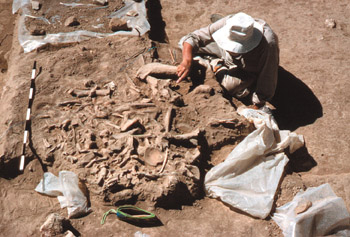
The Gordion Project began in 1950 under the direction of Rodney S. Young (Curator-in-Charge, Mediterranean Section, University Museum) who subsequently directed 17 seasons of excavation. Attention concentrated on the large Phrygian Destruction Level (now dated to ca. 800 B.C.) and the subsequent rebuilding and occupations. After Young's accidental death in 1974, K. DeVries (1974-1987) and then G. K. Sams (1987-present) served as the Gordion Project Director, as analysis, conservation, and publication of excavated material progressed. In 1988-89 excavation resumed under the direction of M. M. Voigt. The goal was a detailed stratigraphic sequence of artifactual, floral, and faunal samples from the Middle Bronze age through the late Hellenistic period (ca 1500-150 B.C.), with particular attention devoted to strata documenting the Late Bronze to Early Iron Age transition. Subsequent excavations conducted in 1993-1997 focused on the development of the Phrygian city from the Middle Phrygian through Hellenistic and early Roman Imperial periods.
After further intensive survey work in the outer town by Andrew Goldman, Lisa Kealhofer launched a detailed regional survey in 1996. Conservation of materials from the R. S. Young excavations continues yearly, under the direction of G. K. Sams and Jessica Johnson, with many of these objects now on display in the newly expanded museum at Yassihüyük/Gordion. Conservation of the wooden objects found in R. S. Young's excavation of tumuli, especially the wooden furniture from the Tomb of Midas, has been carried out in Ankara under the direction of Elizabeth Simpson (Ph.D., Univ. of Pennsylvania, 1985).
